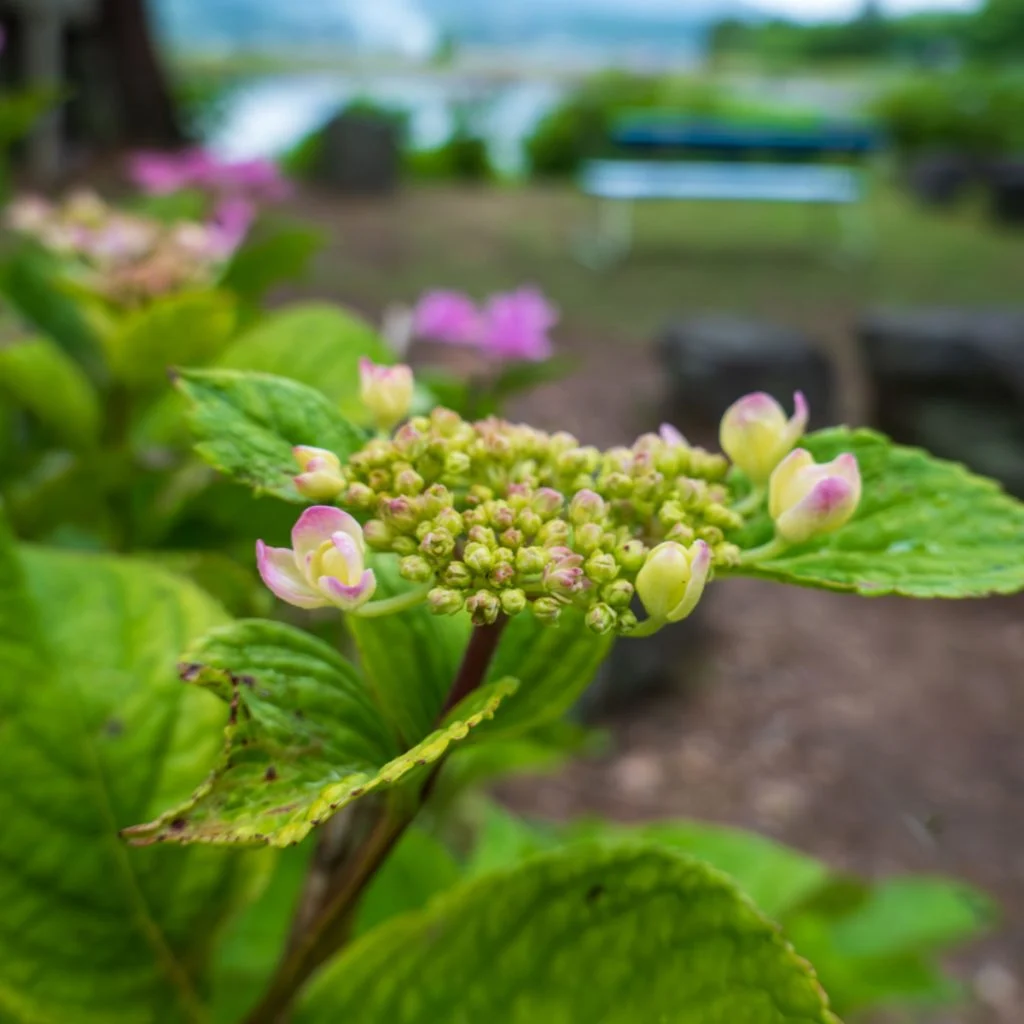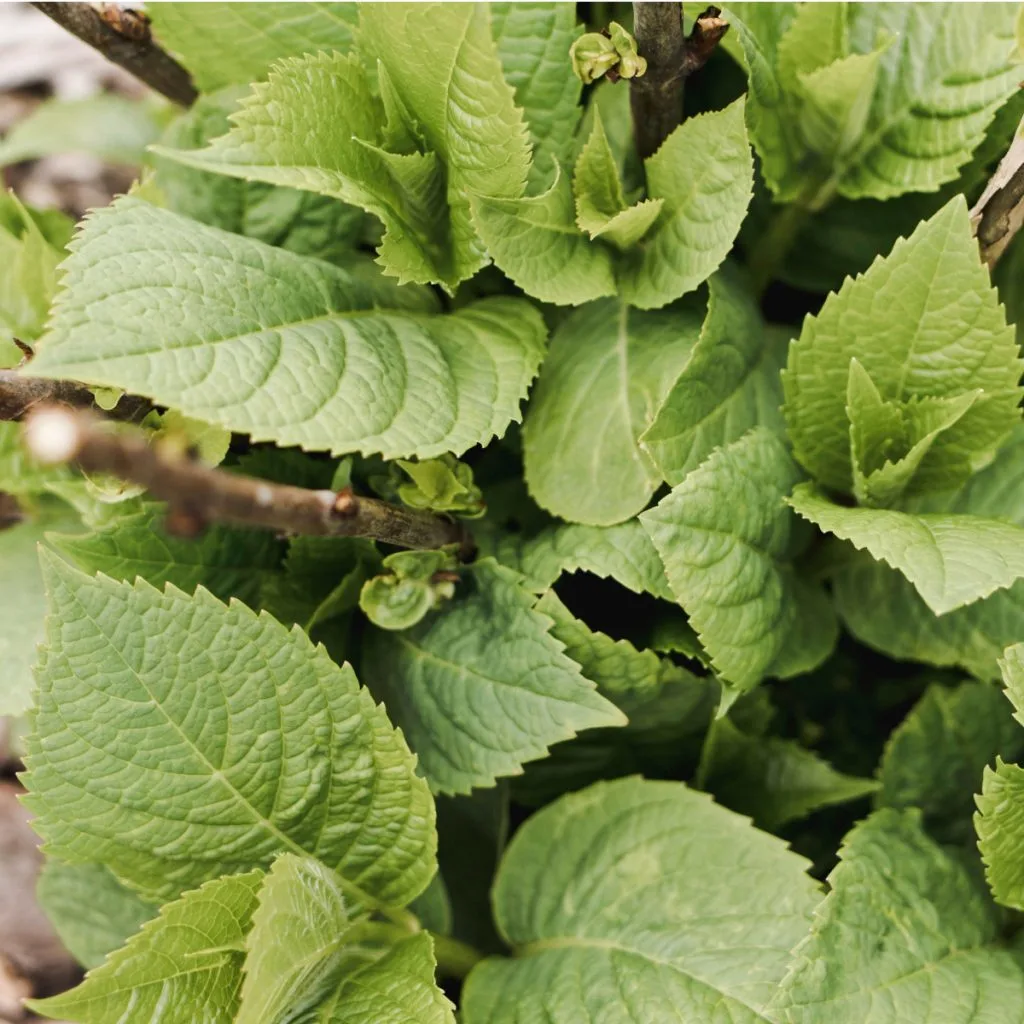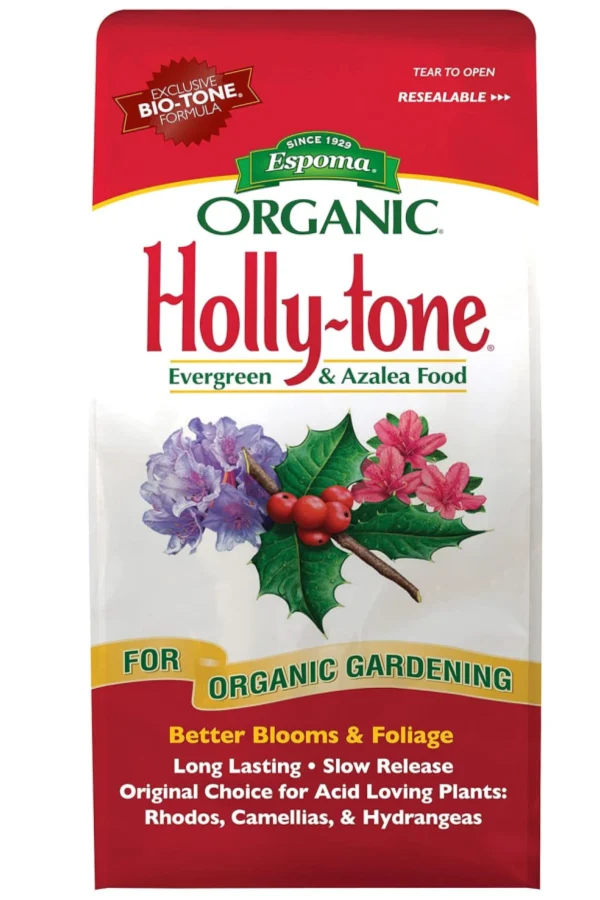Wondering what you should be doing to your hydrangea bushes – and what type of care you need to give them this spring to make sure they stay healthy, strong, and bloom better than ever this year?
What you do in the spring can make all the difference in how many blooms your hydrangeas produce – and how healthy the plant stays throughout the growing season. The good news is that hydrangeas don’t need complicated care to thrive. But they do need a few key things at the right time, especially in spring.
By focusing on a few simple tasks now, you can set your hydrangeas up for a healthy show of bright foliage – and a beautiful display of flowers later in the season!

Spring Hydrangea Care 101
Pruning Hydrangeas in the Spring
For most hydrangea types, pruning is a big no-no in the spring. Different varieties bloom in different ways. Some of the most popular types, like Bigleaf and Oakleaf, bloom on “old wood.”
That means they grow their flower buds the summer before. If you prune these types too heavily in the spring, you might be cutting off the flower buds before they ever get the chance to bloom.
On the other hand, varieties like Panicle and Smooth hydrangeas bloom on “new wood,” meaning they form buds in the same season they bloom. These types can be pruned in early spring without the risk of removing flowers.
If you’re unsure which type of hydrangea you have, it’s best to wait to see how it blooms this season and make notes for next year. When in doubt, it’s always better to be cautious with pruning until you’re certain of the variety.
No matter what variety you grow – you should remove any damaged, broken, or wild growing limbs. Start by looking at the stems of your plant. If you see any broken, dead, or dry stems that aren’t showing signs of new growth, it’s okay to cut them away.

Use clean, sharp pruners and snip the damaged stems back to where you see healthy green growth or to the base of the plant. Removing old and broken stems helps the plant use its energy more efficiently and improves air circulation around the plant, which also helps prevent disease later on.
Fertilizing Hydrangeas For Big Blooms
Once pruning is taken care of, the next big step in spring hydrangea care is feeding your plants. Hydrangeas are heavy feeders, especially when they’re growing and blooming. Giving them the right nutrients early on can really boost their growth and help develop more flower buds.
A good time to apply fertilizer is as soon as you see the bush begin to leaf out. A balanced, slow-release fertilizer that is good for evergreens and contains near equal parts nitrogen, phosphorus, and potassium is a great choice for most hydrangeas. Affiliate Link: Espoma Organic Holly-Tone 4-3-4 Plant Food
This will help with root development, stem strength, and bud formation. If you’re trying to encourage bigger blooms, you can also use a fertilizer that has a little more phosphorus in it. Phosphorus is the nutrient that supports flower development.
Sprinkle the fertilizer around the base of the plant, keeping it a few inches away from the main stem, and water it in well. For more on fertilizing, check out our article: How To Change The Color Of Hydrangeas With Fertilizer!
It’s also a great idea to top-dress your hydrangeas with compost in the spring. Add a couple of inches of compost around the base to help feed the plant naturally. Compost not only adds nutrients but also helps hold moisture in the soil and improves drainage.
Watering & Mulching Hydrangeas In The Spring
Part of spring care is making sure to water your hydrangeas regularly. Hydrangeas need a lot of water, especially when they’re just starting to grow and develop buds. In spring, you might not need to water as often because of rain and cooler temperatures, but as soon as things start drying out, consistent watering becomes more important.
The goal is to keep the soil evenly moist, not soaking wet. Try watering deeply once or twice a week instead of a little every day. Deep watering encourages deeper roots, which helps the plant stay strong during hot summer weather.

Spring is also the time to mulch your hydrangeas. A fresh layer of mulch can help in many ways. It holds moisture in the soil, regulates soil temperature, and helps stop weeds from competing for nutrients.
Apply a 2- to 3-inch layer of organic mulch, such as shredded bark, pine needles, straw, or composted leaves. Just make sure not to pile mulch directly against the stems of the plant. It’s best to keep a small gap around the base to avoid rotting the stems.
Watch For A Late Frost!
If you live in an area where spring temperatures can still swing back and forth, keep an eye on late frosts. A late freeze can damage new growth and developing flower buds. You can protect your hydrangeas by covering them loosely with a sheet, burlap, or frost cloth overnight.
It’s important to remove the cover in the morning so the plant can get sunlight and fresh air. This is especially important for Bigleaf and Oakleaf types that bloom on old wood, since their buds are already in place from the year before.
Here is to getting your hydrangeas ready to bloom big this summer with a little spring care! Once late summer rolls around, be sure to check out: How To Deadhead Hydrangeas In Late Summer – And Why It Matters!
Simple Garden Life
Follow Our Facebook Page For Even More Great Tips! Simple Garden Life Facebook Page
Simple Garden Life is a website dedicated to keeping gardening fun, simple and enjoyable! We publish two new articles each week along with a new garden podcast episode every two weeks. This article may contain affiliate links.

